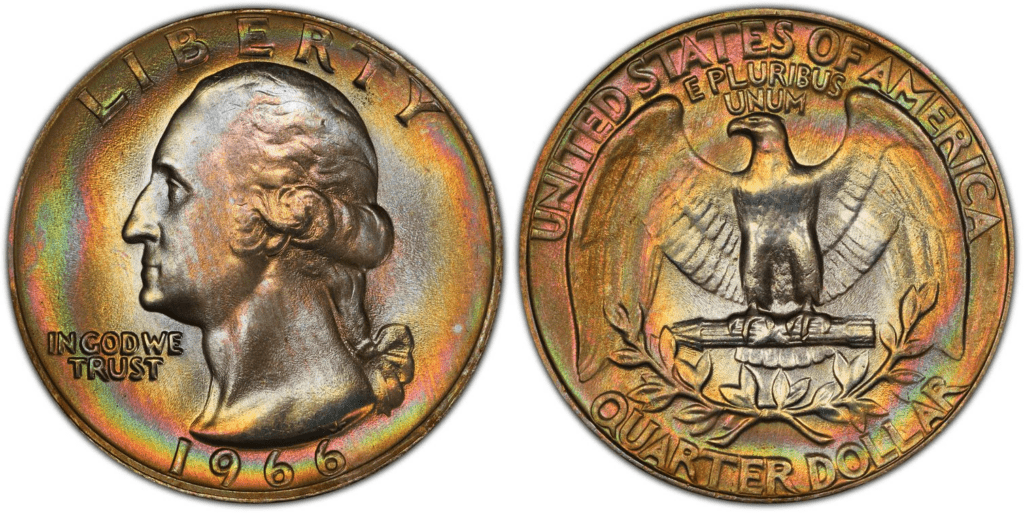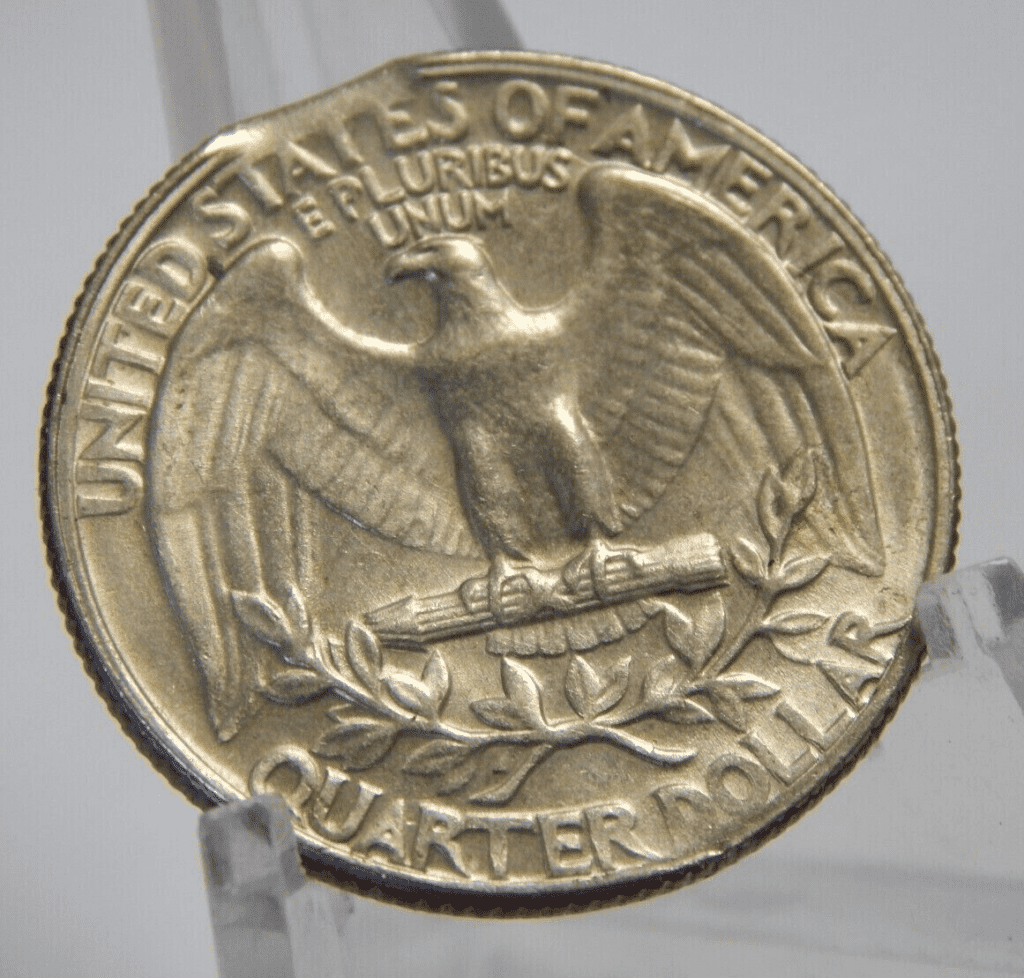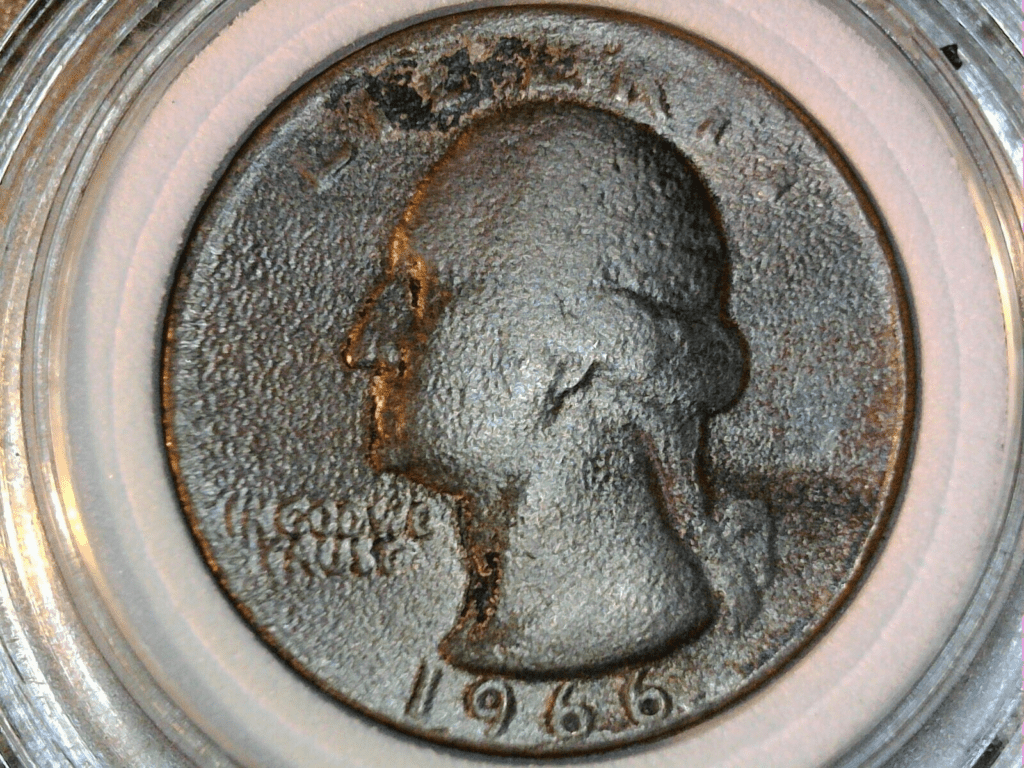What Is the 1966 Washington Quarter Made Of?
The 1966 Washington Quarter is made of 75% copper and 25% nickel. This composition has been in use since 1965. However, before 1965, the Washington quarter was made of 90% silver and 10% copper.
Here are the other specifications of the 1966 Washington quarter coins:
- Value – 25 cents
- Diameter – 24.3 mm
- Mass – 5.67 grams
- Reeded edge
John Flanagan designed the Washington quarter in 1932, the same year when George Washington, the first president of the United States, would have celebrated his bicentennial birth.
Originally, the bicentennial committee proposed to add Washington’s image to the half dollar, which should have replaced the Walking Liberty 50-cent coin. However, Congress instead chose to replace the Standing Liberty quarter with the face of Washington.
The bicentennial committee asked Laura Gardin Fraser to design the quarter. However, her work was later rejected by the Treasury Secretary at that time, who instead chose the design of Flanagan.

photo source: USA Coin Book
When it comes to the design, you will find the bust of Washington on the obverse, facing the left side. On top of his head arches the word “LIBERTY,” which is a fundamental principle of the United States. On his left side, just under the chin, you’ll read the US motto, “IN GOD WE TRUST.” Below Washington is the year of minting, which is 1966.
On the reverse side, you’ll find the heraldic eagle with its wings outspread. He is perched on a bundle of arrows. Below the arrows is an olive branch.
The eagle is the symbol of strength and independence of the United States. The arrows signify the readiness of the United States to defend itself. The olive tree symbolizes peace.
Inscriptions include the following:
- UNITED STATES OF AMERICA
- E PLURIBUS UNUM
- QUARTER DOLLAR
The US Mint used the design of Flanagan from 1932 to 1998. The design will be reused again in 2010.
1966 Washington Quarter Varieties
In the year 1966, the Washington Quarter was only struck in Philadelphia. No official proof coins were issued. The Mint had just ceased the production of silver in 1964. So, the Mint was still adjusting to the new process, which might explain why it was only the Philadelphia Mint that produced the 1966 quarter coins.
Here are the specific details about the 1966 no mint mark (P) Washington quarter:
1966 P Washington Quarter
Year of minting: 1966
Mint Mark: No mint mark (if a mint mark is present, it is found on the obverse, next to the pigtail of Washington)
Place of minting: Denver
Quantity produced: 821,101,500
Face Value: $0.01 (one cent)
Price: $0.25 to $33.00 (or more)
Mass: 2.5 grams
Edge: Plain
Designer: John Flanagan
Composition: 75% copper and 25% nickel
Diameter: 24. 3 mm
Thickness: 1.75 mm

photo source: PCGS
The Philadelphia Mint produced more than 821 billion quarter coins in 1966. You can buy or sell 1966 quarters for 25 cents if it is in average condition. However, a mint state 1966 quarter may be as valuable as $33.
List of 1966 Washington quarter errors
No coin series is free of errors. With thousands of coins produced each day, there’s always a possibility that the minting equipment will fail. Not only that, but human errors may also happen.
There are different types of 1966 coin errors, and the type would depend on what caused the error.
For example, if there’s a misalignment in the die and planchet, the strike may become off-center. Moreover, if the strike were bigger than the planchet, then you would have a broad strike.
There are times when the die strikes the planchet twice. This leads to an error known as doubled die obverse (DDO) or doubled die reverse (DDR).
Here’s an example of a DDO:

photo source: eBay
DDO and DDR errors may not always be obvious. Sometimes, the error is so small that you can’t see it with your naked eye. Coin appraisers would even use a microscope or a magnifying glass to find the error.
Sometimes, the error doesn’t happen during the strike. It happens during the cutting of the planchet. Here’s an example of a 1966 Washington quarter with a clipped edge:

photo source: eBay
The die and planchet may be in good condition. However, if foreign material, such as dust, grease, and metal clippings, come between the die and planchet, you’ll get the strike-through error.
Here’s an example:

photo source: eBay
In the example above, the die didn’t fully contact the planchet because of grease. Thus, the engraved elements weren’t as detailed as they should be.
Error coins are indeed something undesirable. The US Mint would like to avoid this problem as much as possible.
However, a lot of coin collectors are actually after error coins because of their uniqueness and rarity.
How Much Is the 1966 Washington Quarter Worth Today?
The 1966 Washington quarter isn’t that valuable. If you have a 1966 quarter coin that is in circulated condition, you might have a coin with a value that is the same as its face value. The melt value of the 1966 Washington quarter is $0.0573.
If you think about it, you might believe that the 1966 Washington quarter isn’t that valuable. However, if you have a 1966 quarter in good condition or have rare and unique attributes, you might earn more from it.
To give you an idea of the potential earnings that you might have, here’s a 1966 Washington Quarter values chart for you:
| Coin | Condition | Grade | Mintage | Value |
| 1966 P Washington Quarter | Circulated/mint | Not graded | 821,101,500 | $0.25 to $3.00
|
| 1966 P Washington Quarter | Uncirculated/mint | MS-66 | 821,101,500 | $9 to $43 |
| 1966 P Washington Quarter | Uncirculated/mint | MS-67 | 821,101,500 | $60 to $228 |
| 1966 P Washington Quarter | Uncirculated/mint | MS-68 | 821,101,500 | $900 to $11,750 |
As you can see, if you have a graded coin, you will most likely earn more. Just to give you an example, based on PCGS, the auction record for the 1966 Washington quarter is $11,750. This coin was auctioned by Legend Rare Coin in January 2019.
How Does The Grading System Work?
The Sheldon Scale is used by numismatists to provide a numerical value to coins. The Sheldon Scale goes from poor (P-1) to perfect mint state (P-1) (MS-70). Coins were originally evaluated using words to reflect their condition (Good, Fair, Excellent, Etc.). Unfortunately, coin collectors and dealers had different ideas about what each of these terms represent.
Professional numismatists joined together in the 1970s and established CoinGrading standards. These numismatists now assign grades at key places on the seventy-point scale, using the most regularly utilized numeric points in conjunction with the original adjective grade. The following are the most common coin grades:
-
-
- (P-1) Poor – Indistinguishable and probably damaged; if used, must have a date and mintmark; otherwise, rather battered.
- (FR-2) Fair – Nearly smooth, but without the damage that a coin graded Poor often possesses. The coin must have enough detail to be identified.
- (G-4) Fair – Inscriptions have merged into the rims in some areas, and important elements have been mostly erased.
- (VG-8) Very Good- A little weathered, but all of the primary design elements are visible, albeit faintly. There is little if any, central detail left.
- (F-12) Good – The item is very worn, yet the wear is even, and the overall design details stand out clearly. Rims are almost completely isolated from the field.
- (VF-20) Very Fine – Moderately weathered, with some finer features still visible. The motto or all letters of LIBERTY are readable. Both sides of the coin have entire rims that are separated from the field.
- (EF-40) Extremely Fine – Gently used; all gadgets are visible, and the most important ones are bold. The finer details are bold and clear, however, light wear may be seen.
- (AU-50) Uncirculated – Slight evidence of wear on the coin’s design’s high points; may have contact marks; eye appeal should be adequate.
- (AU-58) Uncirculated Choice – Slight traces of wear, no severe contact marks, almost full mint shine, and great eye appeal.
- (MS-60) Mint State Basal – Strictly uncirculated; no indication of wear on the coin’s highest points, but an unsightly coin with reduced luster, visible contact marks, hairlines, and other flaws.
- (MS-63) Mint State Acceptable – Uncirculated, but with contact scratches and nicks, little reduced shine, but otherwise appealing appearance. The strike is weak to average.
- (MS-65) Mint State Choice – Uncirculated with great mint shine, very little contact blemishes, and exceptional eye appeal. The strike is unusually severe.
- (MS-68) Mint State Premium Quality – Uncirculated with superb luster, no obvious contact marks to the naked eye, and exceptional eye appeal. The strike is quick and appealing.
- (MS-69) Almost Perfect Mint State – Uncirculated with perfect brilliance, a sharp and appealing strike, and extremely good eye appeal. A near-perfect coin with minor imperfections in the planchet, strike, and contact markings (seen only under 8x magnification).
- (MS-70) Mint State Perfect – Under 8x magnification, there are no tiny imperfections discernible; the strike is crisp, and the coin is perfectly centered on a beautiful planchet. Rarely seen on a coin, this coin is bright and whole, with original luster and exceptional eye appeal.
-
Where To Buy Or Sell 1966 Washington Quarter?
Perhaps, the fastest and easiest way for you to find a 1966 Washington quarter is through the Internet. In a digital world, you can find the coin you’re looking for with just a simple push of a button.
There are websites today that specialize in buying and selling coins, such as the 1966 quarter. Examples would include Coin Tracker, USA Coin Book, and Grey Sheet.
Aside from that, you can go to popular online selling platforms such as Amazon, Etsy, and eBay. You can just create an account for free and start buying and selling coins.
You can approach coin grading service providers. They may have a list of sellers or buyers who can give you your needed coins. If possible, join social clubs of coin collectors to get more details about where you can buy and sell coins.
Visit coin shops, antique stores, and coin collectors’ hubs. You can also join auctions where some of the rarest US coins are offered.
FAQs
How Much Is A 1966 Quarter With No Mint Mark Worth?
The circulated and ordinary 1966 quarter coin can be just as valuable as its face value, which is $0.25. However, 1966 quarters with at least MS 65 grades should surely be valued at a higher price. Just to give you an example, a 1966 quarter coin with MS 66 grade can be sold for $100 to $200.
Where is the mint mark on a 1966 quarter?
1966 quarter coins don’t have a mint mark, as the Philadelphia Mint doesn’t normally add a mint mark. However, if a mint mark is present, you’ll find it next to the pigtail of Washington.
Is a 1966 quarter real silver?
No, it’s not. The 1966 quarter is made of 75% copper and 25% nickel. Quarter coins made before 1965, quarter coins were made of 90% silver.
What is the value of a 1966 quarter worth if there is mint damage?
The 1966 quarter with mint damage can be sold for $0.25 to $3.





